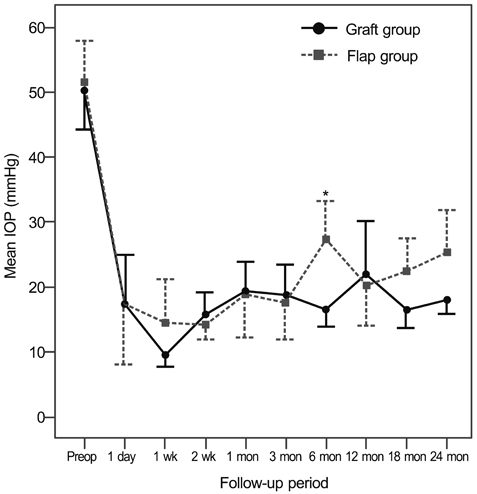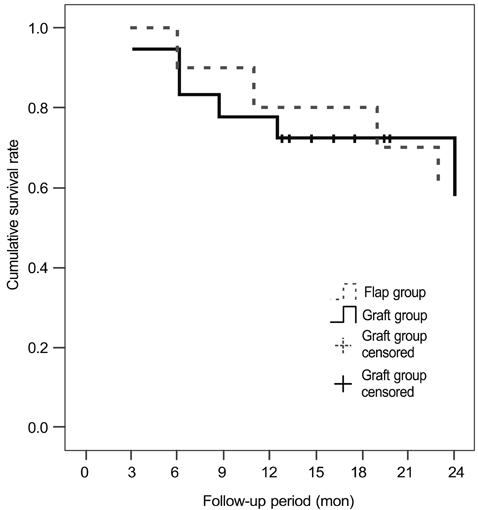Korean J Ophthalmol.
2011 Oct;25(5):317-322. 10.3341/kjo.2011.25.5.317.
Surgical Outcomes of Different Ahmed Glaucoma Valve Implantation Methods between Scleral Graft and Scleral Flap
- Affiliations
-
- 1Department of Ophthalmology, Eulji General Hospital, Eulji University School of Medicine, Seoul, Korea. sarahlhj@eulji.ac.kr
- KMID: 1098633
- DOI: http://doi.org/10.3341/kjo.2011.25.5.317
Abstract
- PURPOSE
To compare the surgical outcomes of the two different methods used for Ahmed Glaucoma Valve (AGV) implantation between the donor scleral graft method and the partial-thickness scleral flap method.
METHODS
We retrospectively reviewed medical records of 28 eyes of 26 patients diagnosed as neovascular glaucoma followed by AGV implantation. Based on the surgical method, the included eyes were divided into two groups. In the graft group (n = 18), the drainage tube was inserted into the anterior chamber, and then covered with preserved donor sclera. In the flap group (n = 10), the drainage tube was inserted under the partial-thickness scleral flap, and then covered with the flap. We compared the postoperative intraocular pressure (IOP), surgical success rates, and postoperative complications between the two groups.
RESULTS
Postoperative IOP was not significantly different between the two groups (p = 0.967, 0.495 at 12 months, 24 months, respectively, by the Mann-Whitney U-test). The mean success periods were 53.1 +/- 10.1 months in the graft group versus 50.9 +/- 9.4 months in the flap group (p = 0.882 by log rank test), and cumulative success rates were 77.8% and 80.0% at one year, respectively. However, tube migration occurred more frequently in the flap group than in the graft group (p = 0.037 by Fisher's exact test).
CONCLUSIONS
In AGV surgery for neovascular glaucoma, the scleral graft method may be associated with relatively less complication about tube migration than the scleral flap method. The surgical results, however, were not statistically different.
MeSH Terms
Figure
Reference
-
1. Broadway DC, Iester M, Schulzer M, Douglas GR. Survival analysis for success of Molteno tube implants. Br J Ophthalmol. 2001. 85:689–695.2. Huang MC, Netland PA, Coleman AL, et al. Intermediate-term clinical experience with the Ahmed Glaucoma Valve implant. Am J Ophthalmol. 1999. 127:27–33.3. Krishna R, Godfrey DG, Budenz DL, et al. Intermediate-term outcomes of 350-mm(2) Baerveldt glaucoma implants. Ophthalmology. 2001. 108:621–626.4. Pine J, Murphy J. Allingham RR, Damji KF, Freedman S, editors. Drainage implant surgery. Shields' Textbook of glaucoma. 2005. 5th ed. Philadelphia: Lippincott Williams & Wilkins;610–625.5. Das JC, Chaudhuri Z, Sharma P, Bhomaj S. The Ahmed Glaucoma Valve in refractory glaucoma: experiences in Indian eyes. Eye (Lond). 2005. 19:183–190.6. Da Mata A, Burk SE, Netland PA, et al. Management of uveitic glaucoma with Ahmed glaucoma valve implantation. Ophthalmology. 1999. 106:2168–2172.7. Yalvac IS, Eksioglu U, Satana B, Duman S. Long-term results of Ahmed glaucoma valve and Molteno implant in neovascular glaucoma. Eye (Lond). 2007. 21:65–70.8. Ishida K, Netland PA. Ahmed Glaucoma Valve implantation in African American and white patients. Arch Ophthalmol. 2006. 124:800–806.9. Souza C, Tran DH, Loman J, et al. Long-term outcomes of Ahmed glaucoma valve implantation in refractory glaucomas. Am J Ophthalmol. 2007. 144:893–900.10. Seiff SR, Chang JS Jr, Hurt MH, Khayam-Bashi H. Polymerase chain reaction identification of human immunodeficiency virus-1 in preserved human sclera. Am J Ophthalmol. 1994. 118:528–530.11. Raviv T, Greenfield DS, Liebmann JM, et al. Pericardial patch grafts in glaucoma implant surgery. J Glaucoma. 1998. 7:27–32.12. Smith MF, Doyle JW, Ticrney JW Jr. A comparison of glaucoma drainage implant tube coverage. J Glaucoma. 2002. 11:143–147.13. Harbison MA, Hammer SM. Inactivation of human immunodeficiency virus by Betadine products and chlorhexidine. J Acquir Immune Defic Syndr. 1989. 2:16–20.14. Resnick L, Veren K, Salahuddin SZ, et al. Stability and inactivation of HTLV-III/LAV under clinical and laboratory environments. JAMA. 1986. 255:1887–1891.15. Sattar SA, Springthorpe VS. Survival and disinfectant inactivation of the human immunodeficiency virus: a critical review. Rev Infect Dis. 1991. 13:430–447.
- Full Text Links
- Actions
-
Cited
- CITED
-
- Close
- Share
- Similar articles
-
- Ahmed Valve Implantation Using Scleral Tunneling
- Surgical Treatment for Tube Erosion after Ahmed Valve Implantation
- Tube Erosion with Scleral Melting after Ahmed Valve Implantation Using a Synthetic Dural Substitute
- Neovascular Glaucoma: Diode Laser Trans-Scleral Cyclophotocoaculation Versus Ahmed Glaucoma Valve Implant
- Clinical Results of Ahmed Valve Implantation in the Aspects of Complications



